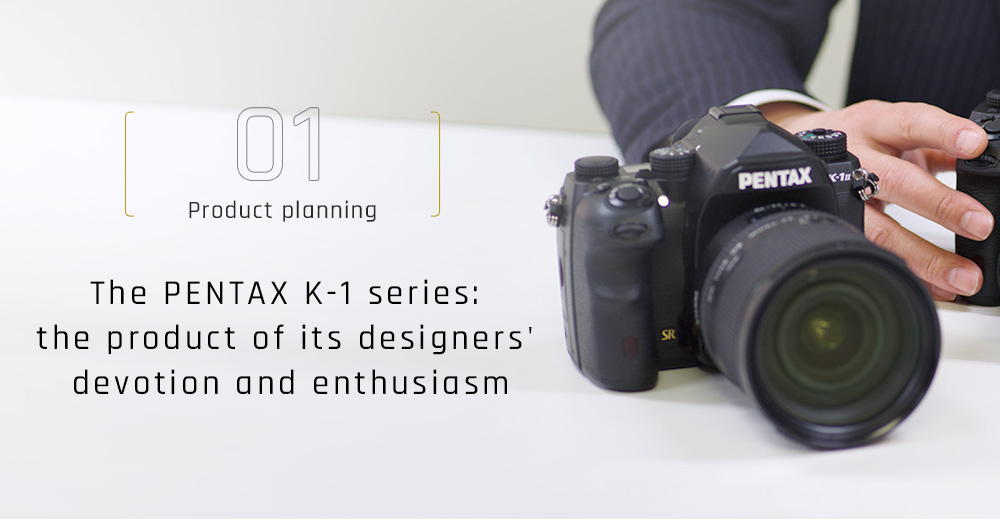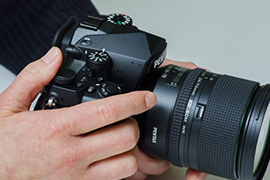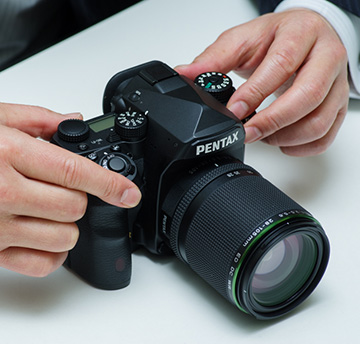

How was the PENTAX K-1 born? The starting point for its development was unique. In an ordinary product development process, RICOH IMAGING’s product planning team initiates a project. Only when this project is officially approved, actual development takes place.
“This wasn’t the case with the PENTAX K-1. In the spring a few years ago, I was invited to a meeting organized by our engineers. At the meeting, I was joined by a group of more than 10 engineers from various engineering fields — mechanical, electrical, firmware designing, and optical,” recalls one of the product development team members. The purpose of the meeting was to discuss the core technologies that would be essential for the development of a 35mm full-frame digital SLR camera. It wasn’t even an official project yet, and no concrete plans had been made regarding the product’s concept or outline. The meeting happened completely because of the engineering designers’ desire and determination to succeed in the project.
Some 10 years earlier, this team member had stressed the necessity of developing lenses that would be compatible with 35mm full-frame models, which he could see lay ahead in the future. At the time, though, PENTAX concentrated on the development of compact, lightweight and high-performance APS-C-size models — a PENTAX specialty—and in optimizing the advantages they had over their competitors. In the following years, the subject of a full-frame model was never mentioned again as a potential for development, even by the product planning team.
Ten years later at this meeting, all the participating engineers were actually facing the planning for a full-frame model. The meeting was named the “Full-Frame Committee,” and was held regularly afterwards.

The answer is always found in the user’s voice


Since this was the first full-frame model for PENTAX, the product planning team was initially unsure about which system to pursue. They could opt for a mirrorless system, which would allow them to design a compact, lightweight model because of the shorter fringe back made possible by the elimination of the mirror box. If this were their choice, it would be more logical and productive to develop a completely new lens mount.
However, our users responded to this issue differently. When the team members traveled to Germany to attend the Photokina event, they were approached by a Pentaxian — an affectionate name given to PENTAX enthusiasts. He expressed his dissatisfaction with the lack of a full-frame model in PENTAX’s SLR lineup. “Thanks to my PENTAX camera, I found the fun of photography, and I want to step up to the next level. However, all PENTAX now offers is the choice of an APS-C-size model or a much larger 645-series model, and nothing in between.”
The team member recalls the event: “At that moment, all of us were reminded that we must do everything to serve our existing PENTAX users. And we were convinced that a new lens mount is out of the question. We would have to develop an SLR camera which would let our users use their K-mount lenses, and would feature the optical viewfinder that has been so highly praised by them.”
We believe in PENTAX’s proud tradition

A full-frame SLR camera equipped with a K mount and an optical viewfinder: In reality, this was the toughest choice to make, because it was extremely difficult to downsize an SLR camera with a mirror box. Besides, if its viewfinder demanded an approximately 100-percent field of view, it would impose considerable restrictions on the optical design.
“We were uncomfortable with existing full-frame models because they were too bulky to handle and lacked operability and maneuverability in the field,” the team member says. “To PENTAX, a leading field camera manufacturer, the natural conclusion was to make the body smaller. But even before we had mentioned this issue to our engineers, they had already started research on how to downsize it.”
With these objectives in mind, the real task of the product development team had begun. They had to speak for users and deliver difficult assignments to the engineers. They knew that two dials, one in the front and another in the rear, wouldn't be enough. At the least, they felt that they had to add an exposure compensation dial to the camera body. The engineers responded to this request. “It doesn’t add any enough value,” they said, and suggested designing a multi-function dial instead. In the end, this exchange led us to the prototype of Smart Function.
Another extremely difficult request made of the engineers was for tilting the LCD monitor horizontally and vertically. The engineers, however, immediately showed a drawing, and asked, “How about this mechanism?” The entire product planning team was amazed. When we requested the addition of a light to assist lens changes and camera operations in the dark, they were ready with an innovative idea: “Let’s place a light behind the flexible tilt-type LCD monitor, and light it up for ease of operation!” We wondered how they could come up with such a fantastic idea.
PENTAX engineers are all craftsmen by nature. If they are convinced that a certain need actually exists, they do their best to make it happen for users. Because we believe in this PENTAX tradition, the product planning team can always consult the engineers about new ideas.
By the time an in-house presentation finally took place, all of us were fully prepared for it. The result was the official launch of the PENTAX K-1 development project.
We pride ourselves on designing a personalized camera

Three members of the product planning team were directly involved in the development of the PENTAX K-1. One took charge of a new D FA lens series. He was responsible for completing a lineup of lenses ranging from ultra-wide angle to super telephoto by the time of the K-1’s release. His objective was to create the distinctive image description demanded by Pentaxians.
“Photographers and users tell us that a certain PENTAX lens stands out in its image description of a particular area, while looking at it on a monitor or print,” he says. “However, it is my job as a product planner to look into what causes this description in terms of various affecting factors, including the type of subject and lens aberrations. I then have to interpret their words in concrete terms that are understandable by optical engineers, and develop the final products.”
This lens planner initially worked in the field of lens barrel design. His expertise as an engineer and analytical skills as a product planner are evident in the outstanding imaging power of the D FA-series lenses.
Another member was assigned the task of assessing the K-1’s operability, in collaboration with the GUI (graphic user interface) design team. After a series of intense discussions, he was the person responsible for finalizing the specifications of Smart Function. Originally a mechanical engineer, he had previously worked for several camera manufacturers and developed a very critical eye for cameras. It is interesting to hear his opinion of PENTAX.
“For better or for worse, today’s industrial products are very refined, whether it’s a camera or car,” he says. “I believe, however, that the PENTAX K-1 offers something beyond explanation. It integrates the different values and demands of many users. Consequently, it embodies elements of both praise and criticism. But all these elements are interlinked with one another to create a single entity called the PENTAX K-1. I think that’s what makes this camera so interesting, and what excites every Pentaxian.”
Because it’s such a unique camera, it will be well worth the effort to discover its true value for photographers across the globe. That’s what the PENTAX K-1 truly is!


In April of 2016, we launched the much-anticipated PENTAX K-1. This, PENTAX’s first 35mm full-frame, K-mount digital SLR camera, was enthusiastically received by PENTAX fans. “We received many favorable comments on the PENTAX K-1,” says a spokesperson for the camera’s Product Planning Team. “We were very confident when we introduced the camera, because we incorporated into it the most advanced technologies available. In this age of rapid technological advancement, however, every day we saw that new technologies could make the camera better, and please our users even more.” Our concept was that, once we reach the immediate peak, we can then identify the next peak. The entire Product Planning Team shared a renewed inspiration to climb toward the newest peak of technology.

The mission of creating ever-lasting evolution


The development of an original accelerator unit was underway at the same time as the development of the PENTAX K-1. This accelerator unit was incorporated into the PENTAX K-70 and PENTAX KP — APS-C-format digital SLR models which would later be marketed — and was highly acclaimed for its outstanding performance. The team felt that, if we took advantage of the knowledge gained by installing the accelerator into these APS-C-format models and installed it in the PENTAX K-1, we would be able to upgrade the camera’s imaging performance in the high-sensitivity range (an important factor in the shooting of dimly lit scenes) without compromising its remarkable resolving power, essential to the reproduction of fine details in field photography. The Product Planning and Development teams also felt that this technology was the key to the camera’s evolution. As expected, the accelerator unit incorporated into the PENTAX K-1 Mark II not only helped achieve the super-high top sensitivity of ISO 819200 by employing the combination of the PRIME IV imaging engine and the 35mm full-frame sensor, but also greatly improved image quality at normal sensitivity ranges.
The Pixel Shift Resolution System, the latest super-resolution technology, was also brought up to a new peak. Handheld shooting using the Pixel Shift Resolution System was one feature that the Product Development Team wanted to incorporate into the PENTAX K-1 Mark II. In fact, the Development Team was working on this feature even before the Product Planning Team proposed the idea. When a revolutionary, unconventional mechanism was finally designed, it even impressed the Product Planning Team — who knew every detail of camera design —with its technical intricacy and imagination involved. This upgraded system improved other camera functions as well, such as AF tracking accuracy, making the PENTAX K-1 Mark II much more versatile in field photography.
A new challenge: the upgrade service

PENTAX has always worked hand in hand with PENTAX users. A good example is how the PENTAX K-1 was created in response to enthusiastic requests over many years for a 35mm full-frame, K-mount digital SLR camera. That’s why PENTAX wanted to make the new and exciting functions to the PENTAX K-1 Mark II available to current PENTAX K-1 users. This resulted in the launch of the PENTAX K-1 upgrade service, a totally new concept in the camera industry.
Simply by replacing the PENTAX K-1’s circuit board, an existing PENTAX K-1 can be upgraded to deliver the performance of the new PENTAX K-1 Mark II. Even though this was a very challenging endeavor, it embodies the Product Planning Team’s hope that the PENTAX K-1 will continue to be cherished and used for many years to come. We are planning to provide this exclusive service to PENTAK K-1 users, not only in Japan but also in other international markets.
The PENTAX K-1 Mark II is a product which embodies the wishes of PENTAX employees: the desire to achieve ever-lasting evolution, and the wish that the camera will be used for many years. It’s PENTAX’s new 35mm, full-frame digital SLR camera flagship. PENTAX hopes it will attract the interest of all photographers: those who have become interested in digital SLR photography for the first time; those who have decided not to buy the PENTAX K-1 for some reason; and, indeed, all photo enthusiasts.
















